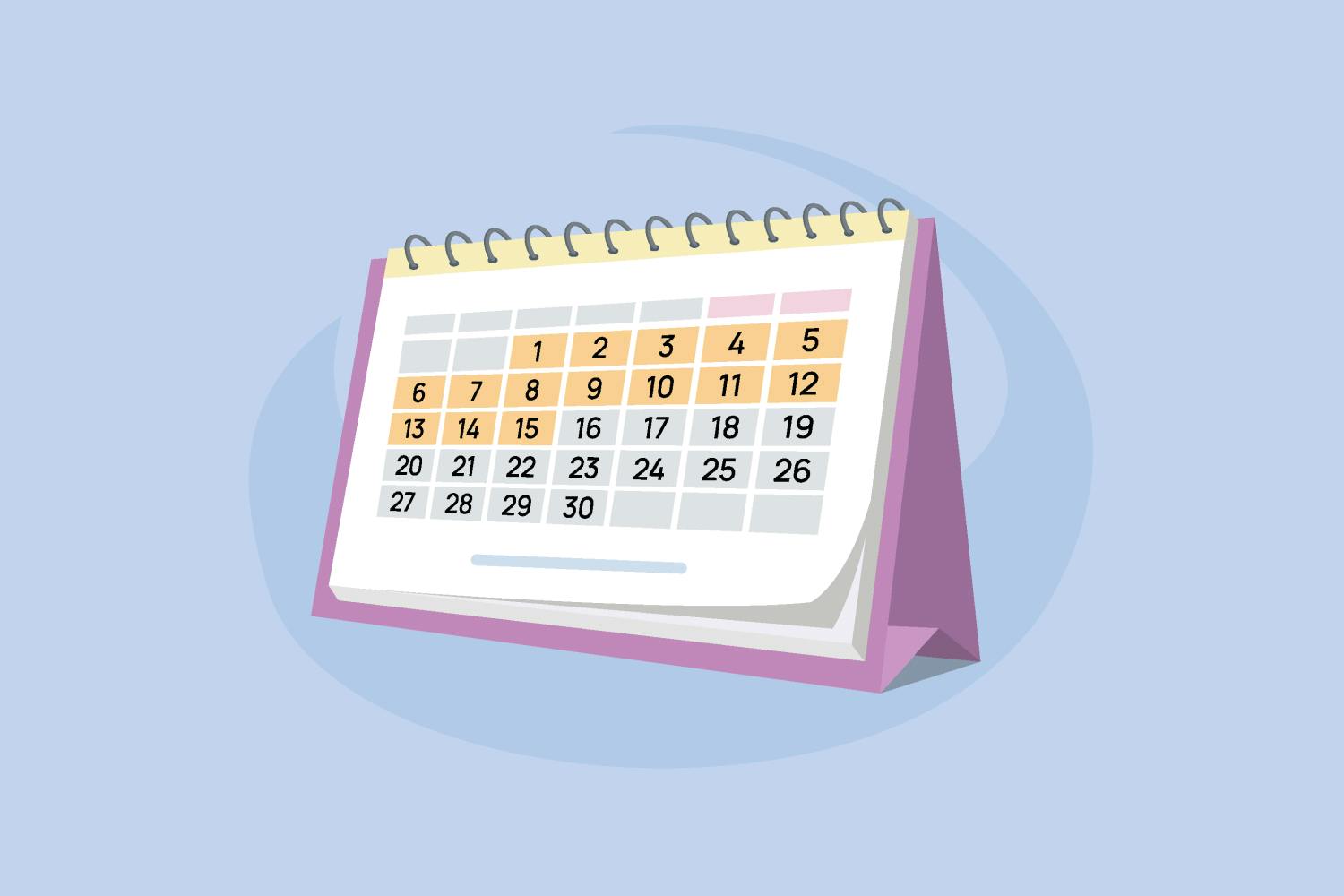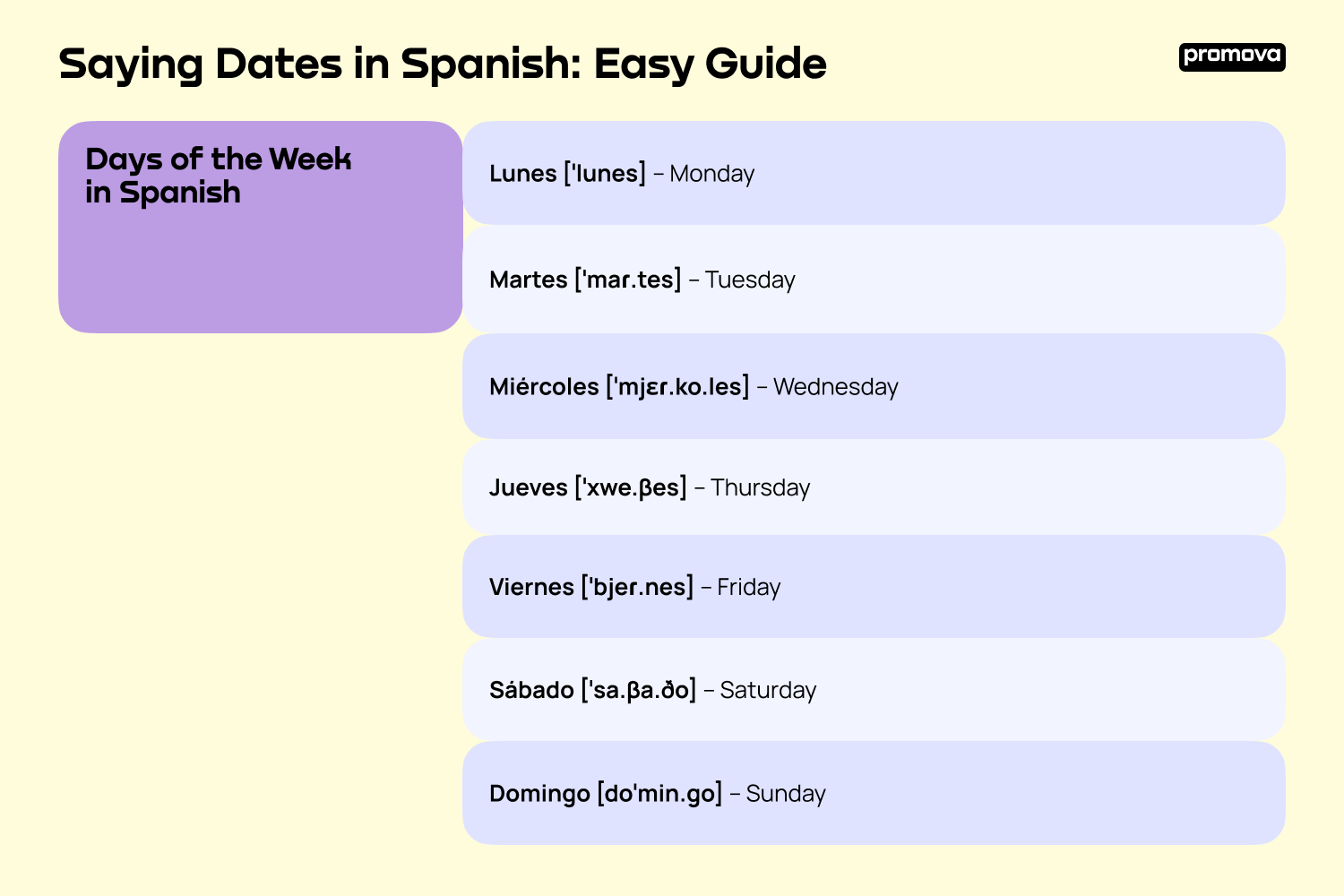Saying Dates in Spanish: Easy Guide

Contents
Understanding how to write the date in Spanish is essential for anyone looking to communicate effectively in this language. The format differs slightly from English but is easy to grasp with some practice. Whether you need these skills for travel, work, or studying abroad, having this knowledge at your disposal can enhance interactions and foster a smoother communication process. In this article, you will explore the tips and rules on expressing dates accurately.
Standard Format: How to Say the Date in Spanish
Understanding the standard format for dates is crucial for clear communication. Unlike the month-first approach common in the US, Spanish typically follows a day-month-year sequence. This format aligns with many other global standards and has a familiar structure for many learners.
When writing, the day is first, followed by the month, and then the year. For instance, here’s how to say the date in Spanish: 15th July 2023 becomes 15 de julio de 2023. The inclusion of ‘de,’ meaning ‘of,’ is a key difference from English. It acts as a connector between elements of the date. In spoken Spanish, this format remains consistent. Saying the date aloud would sound like quince de julio de dos mil veintitrés [ˈkinse ðe ˈxuljo ðe ðos mil βein̪tiˈtɾes].
It’s important to note that in Spanish, months are not capitalized. So, ‘July’ becomes ‘julio.’ This slight distinction is essential for proper written language. In formal writing, such as in legal or official documents, the full year is often written out. However, in everyday conversation and informal writing, it’s common to use the shortened version of the year, just as in English. For instance, ‘2023’ can be simply veintitrés [bein̪tiˈtɾes] after mentioning the millennium and century earlier.
Whether filling out documents, planning events, or simply discussing dates in conversation, understanding the Spanish date format guarantees effective and accurate communication. So, take the time to familiarize yourself with this concept. As you practice, it will become second nature.
Days of the Week in Spanish
While learning to express dates in Spanish, it’s also useful to familiarize yourself with the days of the week. Here’s a table to illustrate each day along with its English equivalent:
| Spanish | English |
| Lunes [ˈlunes] | Monday |
| Martes [ˈmaɾ.tes] | Tuesday |
| Miércoles [ˈmjɛɾ.ko.les] | Wednesday |
| Jueves [ˈxwe.βes] | Thursday |
| Viernes [ˈbjeɾ.nes] | Friday |
| Sábado [ˈsa.βa.ðo] | Saturday |
| Domingo [doˈmin.go] | Sunday |
When you write dates in Spanish, you’ll often find them in phrases like el lunes [eɫ ˈlunes] (on Monday) or los lunes [los ˈlunes] (on Mondays) to specify a particular day or recurring days. For example, La reunión es el lunes [la re.uˈnjon es el ˈlunes] means ‘The meeting is on Monday.’
It’s also worth noting that the week in many Spanish-speaking cultures traditionally starts on Monday, not Sunday. This is reflected in calendars and planning. Understanding these days and their correct usage can significantly enhance your ability to navigate conversations and texts.

Months of the Year and Their Spanish Equivalents
Knowing the months of the year in Spanish is another building block to express dates efficiently. While resembling their English counterparts, they have distinct names. Here is a list of each month:
- Enero [eˈne.ro] – January.
- Febrero [fe.ˈβɾe.ro] – February.
- Marzo [ˈmaɾ.so] – March.
- Abril [aˈβɾil] – April.
- Mayo [ʝaio] – May.
- Junio [xu.njo] – June.
- Julio [xu.ljo] – July.
- Agosto [a’ɣos.to] – August.
- Septiembre [sepˈtjem.bɾe] – September.
- Octubre [ok’tub.re] – October.
- Noviembre [no’bjem.bɾe] – November.
- Diciembre [di’sem.bɾe] – December.
Understanding Spanish dates and months is fundamental for anyone learning the language, particularly when dealing with dates. Each name corresponds closely to its English equivalent, aiding in easier recall and application. Remember, in written Spanish, these month names are capitalized only if they appear at the beginning of a sentence.
Expressing Years in Spanish
Communicating years in Spanish has its own set of rules and nuances. Unlike English, where the year is often broken into two parts (like twenty-twenty-one for 2021), in Spanish, it’s more common to say the year as a whole number. Here’s a breakdown of how to express years:
- Years in the 2000s. These are straightforward. For instance, 2023 is dos mil veintitrés [dos mil βeintiˈtɾes].
- 20th century and before. Years like 1985 are expressed as mil novecientos ochenta y cinco [mil noβeˈsjentos oˈtʃenta i ˈθiŋko]. This translates directly to ‘one thousand nine hundred eighty-five.’
- Years before 1000. These are simply said as they are, like 956 would be novecientos cincuenta y seis [noβeˈsjentos sinˈkwenta i sejs].
In spoken Spanish, especially in informal contexts, people often shorten the years when the context is clear. For example, 2021 might be referred to simply as veintiuno [bein̪ˈt̪i.uno] if it’s understood that the discussion is about the 2000s.
Remember, these rules apply universally across Spanish-speaking countries, making understanding years crucial for oral and written communication. Mastery of expressing years will significantly enhance your ability to converse about historical events, personal milestones, or planning future activities.
1
Essential Vocabulary Related to Spanish Dates
When discussing dates in Spanish, knowing the key vocabulary that frequently appears in such conversations is beneficial. Here’s a list of essential date-related words, their pronunciation, and usage in sentences:
- Hoy [oɪ] – Today
Hoy es mi cumpleaños. (Today is my birthday.)
- Mañana [maˈɲana] – Tomorrow
Nos veremos mañana. (We will see each other tomorrow.)
- Ayer [aˈʝeɾ] – Yesterday
Ayer fue un día increíble. (Yesterday was an incredible day.)
- Semana [seˈmana] – Week
La próxima semana estaré de vacaciones. (I will be on vacation next week.)
- Mes [mes] – Month
Este mes está lleno de trabajo. (This month is full of work.)
- Año [aˈɲo] – Year
El próximo año iré a España. (Next year I will go to Spain.)
- Fecha [ˈfetʃa] – Date
¿Cuál es la fecha de hoy? (What is today’s date?)
- Cumpleaños [kumpleˈaɲos] – Birthday
Mañana es el cumpleaños de Juan. (Tomorrow is Juan’s birthday.)
- Aniversario [aniβeɾˈsaɾjo] – Anniversary
Hoy celebramos nuestro aniversario. (Today we celebrate our anniversary.)
- Día [ˈdi.a] – Day
Cada día aprendo algo nuevo. (Every day I learn something new.)
- Fin de semana [fin de seˈmana] – Weekend
Este fin de semana vamos a la playa. (This weekend we are going to the beach.)
- Calendario [kalenˈdaɾjo] – Calendar
Debo mirar el calendario para confirmar la fecha. (I need to check the calendar to confirm the date.)
- Estación [es.taˈθjon] – Season
Mi estación favorita es la primavera. (My favorite season is spring.)
- Década [ˈdekaða] – Decade
Muchas cosas cambiaron en la última década. (Many things changed in the last decade.)
- Siglo [ˈsiɣlo] – Century
El siglo XX fue testigo de grandes avances. (The 20th century witnessed great advancements.)
- Anual [aˈnwal] – Annual
La asamblea anual es en noviembre. (The annual assembly is in November.)
Writing Dates in Spanish Text
When writing dates in Spanish, following specific conventions is important to ensure clarity and correctness. Here are some key points to remember:
- Date format. The standard Spanish date format is ‘DD de MM de YYYY.’ For example, July 22, 2023, would be written as 22 de julio de 2023.
- No capitalization. Unlike English, the names of days and months are not capitalized in Spanish unless at the beginning of a sentence. So, ‘enero,’ ‘febrero,’ ‘marzo,’ etc., are always lowercase.
- Use of ‘de.’ The word ‘de,’ meaning ‘of,’ separates the day, month, and year. It acts as a critical component in the structure of the date.
- Abbreviations. In more informal contexts or to save space, months can be abbreviated. For instance, 7 de sept. de 2023 for 7 de septiembre de 2023. However, these abbreviations are less common than in English.
- Ordinal numbers for the first day of the month. When writing the first day of the month, primero [pɾiˈmeɾo] is used instead of uno [ˈuno]. For example, ‘1st May’ is 1 de mayo or primero de mayo.
Adhering to these guidelines guarantees that dates in Spanish format are written correctly. This knowledge is particularly useful for formal communication, academic writing, or any context where precise date representation is required.
Promova: Your One-Stop Solution for Language Learning
Looking to improve your language skills? Promova is the perfect choice for you. It’s an innovative learning platform that offers lessons in various tongues, including English, Italian, Spanish, French, and many more. Dive into our structured courses, and you will get access to a wealth of materials tailored to help you grow your vocabulary, grasp complex grammar rules, and evaluate your progress with thorough quizzes.
If English is your focus, we have something special for you. Take control of your learning with our 1x1 lessons seamlessly accessible via our app and the web. Our expert tutors will tailor each session to align with your goals and pace. Group lessons are another fantastic feature for those who enjoy a collaborative learning environment. Here, you can engage with peers and benefit from a shared English learning journey.
Enhance your language acquisition further by exploring the rich content on our blog. You’ll discover various insightful articles catering to different aspects. For instance, if you’re keen on picking up Spanish, you can find helpful posts on how to greet someone with a simple Hola or dive into the world of Spanish colors. So, learning with Promova means having a multitude of resources at your fingertips.
Conclusion
Mastering the structure and conventions of date expressions is crucial for effective communication. It involves understanding differences between English and Spanish formats, such as day-month-year sequence, lowercase month names, use of ‘de,’ and unique abbreviations. The days of the week and months resemble their English counterparts but require specific pronunciation. With consistent practice in saying dates in Spanish articulately, one can avoid confusion and communicate seamlessly across various contexts.
FAQ
How do you express decades in Spanish conversation?
In Spanish, decades are referred to by the tens digit, followed by the word años [ˈaɲos] (years). For example, the 1980s would be los ochenta años [los oˈtʃenta ˈaɲos] or simply los ochenta. This term is often used to refer to that period’s cultural or historical aspects, much like in English.
How is time referenced in Spanish?
Time is usually expressed in a 24-hour format in formal contexts, like timetables or official documents. In everyday speech, however, the 12-hour clock is commonly used, with ‘a.m.’ and ‘p.m.’ often replaced by de la mañana [de la maˈɲa.na] (in the morning), de la tarde [de la ˈtaɾðe], or de la noche [de la ˈnotʃe] (in the afternoon/evening or night).
Are there any specific tips for pronouncing years in Spanish more naturally?
When pronouncing years, especially recent ones, it’s common to split them into two parts. For example, 1999 is pronounced as mil novecientos noventa y nueve [mil noβeˈsjentos noβen̪ˈta i ˈnweβe], effectively breaking it down into a more manageable, rhythmic pattern. This helps in achieving a more natural flow of speech.
Where can I learn more Spanish phrases and expressions?
Resources like Collins Dictionary offer comprehensive dictionaries and phrase guides for expanding your vocabulary beyond the date in Spanish. For more advanced learners, BBC Languages has a range of resources, including video and audio content. Also, the Promova Spanish language learning app is an excellent tool for learning new phrases and expressions in a fun and interactive way.
Comments